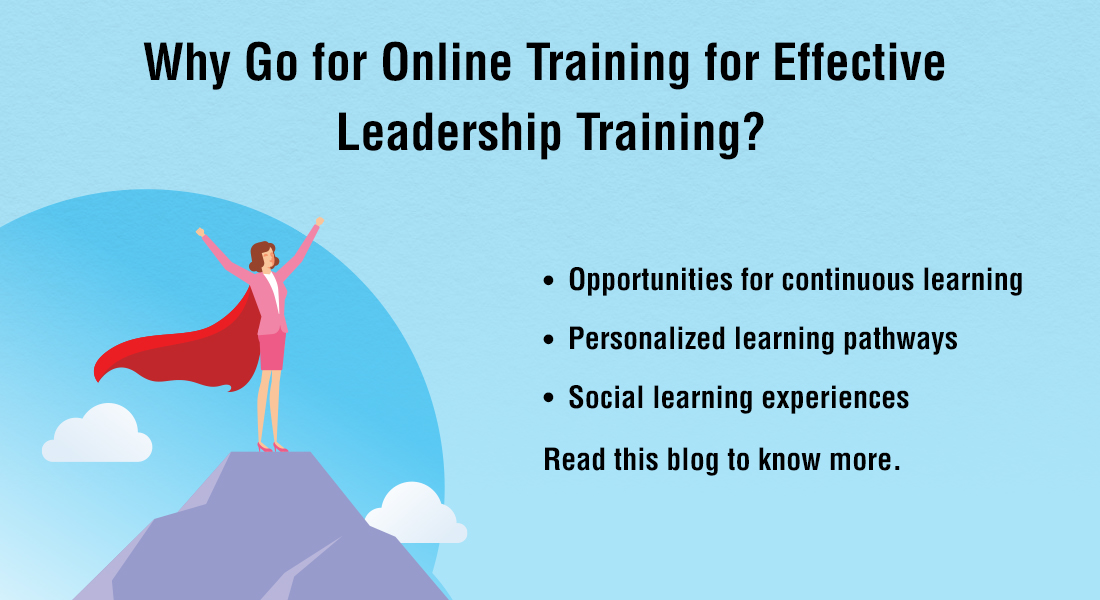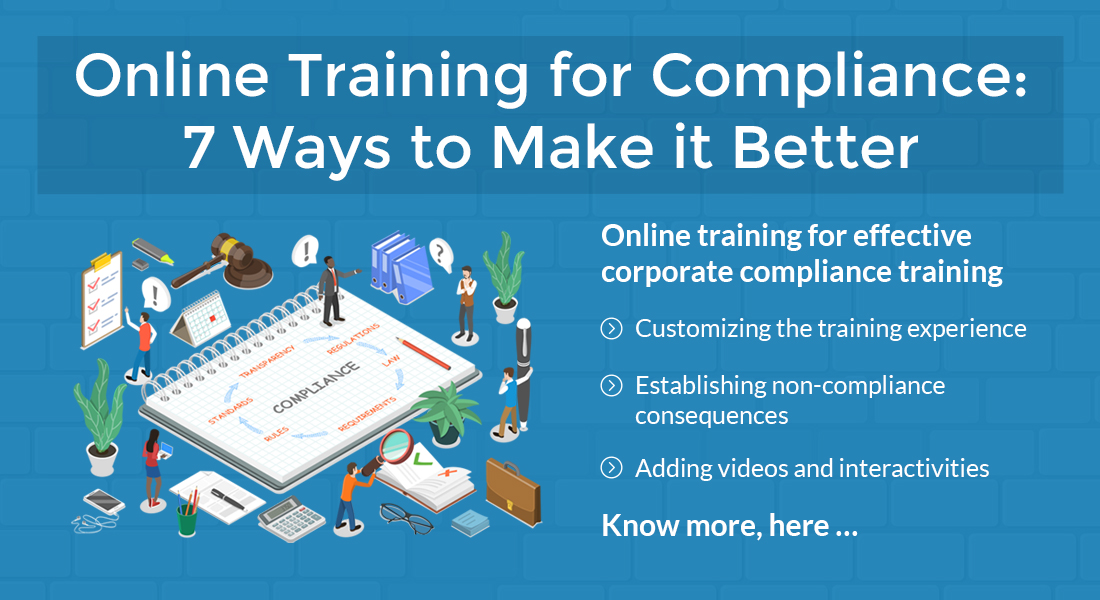Fostering Corporate Leadership Skills through Online Training

Hello training managers! I am glad you are interested in today’s discussion on corporate leadership and if and how online training can help foster leadership skills.
Why Online Training is the Preferred Method for Leadership Training
- Provides a continuous learning experience
- Is not a one-size-fits-all solution
- Trains learners to become critical thinkers and decision-makers
- Gives learners a social context to prove themselves
- Transcends time and distance to create effective leaders
According to a study by Mercer, global executives have recognized leadership as one of the top skill gaps in organizations. Why? Because until the last decade, most executive (leadership) positions were filled by the generation of baby boomers. And now we have a demographic shift with almost 80 million baby boomers nearing retirement in the next decade and a new generation of wide-eyed millennials waiting to take their place. Plus, hiring and retaining people at executive positions is fairly expensive and difficult. It’s way more prudent for organizations to train and create effective leaders from their current workforces.
Creating Leadership: Is Training Even Necessary?
Speaking of creating new leadership, you must have heard the phrase, “born leader”. Huh! If leadership is a skill that one is born with, then what is this discussion about leadership training through eLearning all about?
The truth is, when we talk about leaders, we often talk about their qualities – like being a great orator with a velvet tongue or having a charismatic personality. Or having a natural ability for making friends, acquaintances, and connections. All these characteristics make it seem as though some people have an innate gift for becoming a leader and others don’t. That’s not true.
Though leaders are often recognized by their many charming traits, true leadership is not about ‘self’ but about being of service to others. Great leaders are recognized for their ability to make others around them believe in a common goal and help them achieve it. It’s about recognizing the potential in others and helping them improve their performance to reach that potential. And this ability is something that is learned through knowledge, empathy, and experience.
People are not born leaders, they learn how to lead. Most leaders (75%) say online training can enable them to do their jobs better and faster because it is convenient, self-paced, need-based, and is able to reach across boundaries. Let’s discuss this in detail.
Find how to evolve at the speed of business with rapid eLearning – solution to all training needs.
Enforcing Leadership Skills through Online Training
1. ‘Once is Not Enough!’: Leadership Requires Continuous Learning
We keep saying that learning is not a one-time event. That is especially true for leadership training. One can’t just sign-up for a 3-day workshop on leadership and emerge a leader by the end of it. (That would be nice though). Training to be a successful leader requires continuous learning, staying ahead of trends, and leading by example, and not all of it comes strictly from formal training.
You cannot create leaders through a few discrete formal training sessions around the year. Instead, you need to encourage and enable continuous learning and provide learning pathways that can connect different kinds of training that the learner can go through. A one-off in-person classroom training event can’t make it happen.
Online training on the other hand makes continuous learning convenient.
- ‘Bite-sized’, action-oriented multiple microlearning nuggets that are tied together in a learning path can be used to deliver reinforcement training to beat the forgetting curve.
- Online training also allows access to information anytime, anywhere through mobile learning. Providing just-in-time performance support to learners is also incredibly easy through online training.
- You can also include social learning elements in online training to encourage learners to access and share information, tips, and hacks that they can use in their jobs. They can discuss and brainstorm ideas and support one another in their learning.
2. There are NO ‘One Size Fits All’ Training Solutions in Leadership Training
Leaders come in all shapes and sizes and departments and backgrounds. Some can be entry-level leaders and some can be higher up in the corporate totem pole. That means not all learning points can be the same for all learners. Successful leadership training requires a more personalized learning experience and individual learning paths – both in terms of training topics and methods. You can:
- Offer a diverse range of online microlearning assets that will resonate with learners at each level – videos, audio podcasts, problem-based exercises, etc. These assets will also appeal to learners of different ages and learning styles.
- Create personalized pathways for learners using a Learning Management System (LMS). It’s even more effective if you can use a more experiential platform like LXP or use adaptive learning.
- Use blended learning to give learners the benefit of an instructor-led session either in a brick n mortar classroom or through a VILT platform to complete the spectrum.
3. Leadership Requires Situational Awareness and Contextual Information
Leadership training is not technical or information-based training. It requires learners to develop their soft-skills, situational awareness, critical thinking, and the ability to make strategic decisions. These are not skills one can develop by just reading a bunch of notes and manuals. That is why online training is such a great method to train learners on leadership skills. You can use branching scenarios, simulations, and case studies to give learners all the contextual information they need for them to become effective leaders.
- Branching scenarios allow learners to analyze a situation, think critically, and make decisions. They teach learners that the best course of action depends on the circumstances they’re facing.
- Simulation-based training prepares learners for what they are going to face in their jobs and enables them to practise their new skills in a safe environment.
- Case-studies are a great way to take learners through a story – from when a situation arises, to how it is analyzed and finally resolved using the knowledge they gained through formal training.
4. ‘No Man is an Island’ and Neither is Effective Leadership Training: It Does NOT Happen in Isolation
The primary job description of leaders is to lead others. It doesn’t take a genius to figure out that successful leadership training is impossible without collaboration. Though social learning is not strictly an eLearning phenomenon, it would be fair to say that the scope of social learning increases tremendously through online training.
Using social learning for leadership training serves as a two-way street.
First, it can be a great way to build collaboration among learners, have them discuss and brainstorm and come up with new ideas, encourage them to share their work-related anecdotes, and interact with seniors and industry thought leaders. All this can be easily done through online social learning elements like discussion boards, chat rooms, social media pages, virtual events, etc.
Second, social media also provides a unique way of accessing learners and identifying those who have the potential to become leaders. For instance – during a discussion on a given topic in a discussion board it is easy to see a learner who is taking the lead, not getting into arguments to prove a point, but listening to others and trying to resolve conflicts. Such learners can be identified and given further training.
5. True Leadership is Created by Crossing Boundaries
If you look at all employees in leadership positions in your organization, you won’t find them in a particular team or department or division. Leaders are present in every team, every department, every business division, and yes, even in different geographical locations. While their learning levels can differ, they all still need to reflect your organizational values. They also need to have uniformity and consistency in their training. How can you do that if your workforces are located in different geographical locations?
Classroom training is of not much help when it comes to reaching across boundaries. You need online training to achieve this feat. More importantly, you’ll need to go for eLearning translation and localization to eliminate the barriers of time and distance and create effective leadership across borders.
End Note
Leadership training is unlike any other training that happens in a corporate environment. It is almost like a combination of different types of training put together to help learners become more sensitive to their peers, their work, and the industry, and use their knowledge to improve business performance. And online training does a great job of connecting the dots to create an effective learning experience.
While eLearning-only can surely yield better results than classroom-only training, it is blended learning that is the most preferred training approach when it comes to leadership training. Want to know why? Download our eBook.




![5 Social Learning Tips for Effective Online Training [Infographic]](https://blog.commlabindia.com/hubfs/Imported_Blog_Media/social-learning-tips-online-training-info.jpg)
